If I could share just one secret with aspiring email marketers, it would be the strategy I’m revealing right here on this page.
I’m going to start by explaining the difference between first-level and second-level thinking as it’s related to email marketing. I’ve created an example email funnel to make it easier for you to understand.
In this example email funnel, an affiliate marketer has been running Facebook ads to a blog-post-style landing page like this:
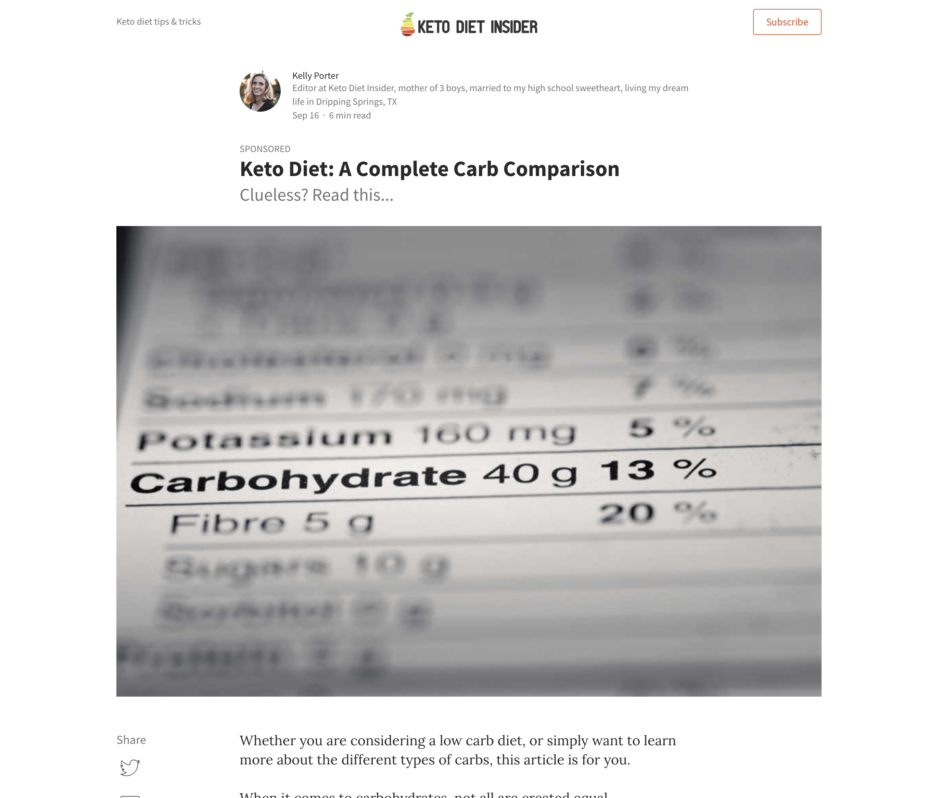
The goal here is to get people to subscribe to their email list before they promote affiliate products.
He’s currently getting a 10% opt-in rate from this blog post. “TEN PERCENT?! That’s horrible,” he says.
So he switches to a classic squeeze page like all the gurus have told him to do in the past.
Now he’s getting a 47% opt-in rate. “FORTY-SEVEN PERCENT!! I’m a genius!!”, he tells his wife.
This is First-Level Thinking.
He’s only concerned with increasing his opt-in rate, which is the first step of the funnel.
Problem is, his end result is to make money. He’s ignoring the entire backend of his affiliate funnel and is oblivious to the fact that by switching his frontend pages, he’s affecting the rest of the business.
Take a look at the image below…
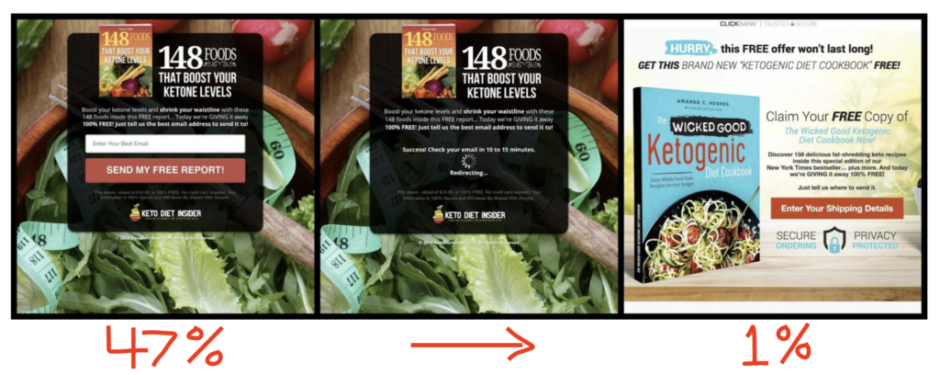
That’s what his entire funnel looks like after he switched it to a classic squeeze page.
A 47% opt-in rate and 1% of those people purchased the affiliate product he’s promoting.
Lets put some real numbers to this…
1,000 visitors to his squeeze page results in 470 subscribers and 4 of them buy.
Let’s go back to his original funnel:
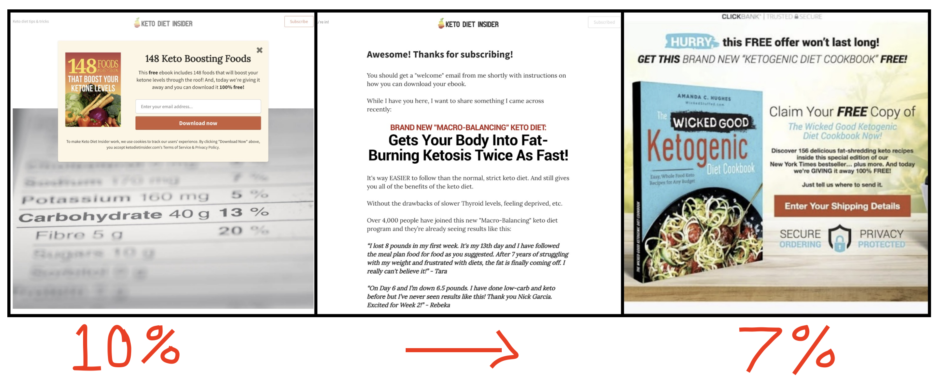
Remember, he was only getting a 10% opt-in rate on this blog post page.
But what he didn’t realize was, 7% of those subscribers were buying the affiliate product he was promoting.
Again, here’s that with real numbers applied…
1,000 visitors to his squeeze page results in 100 subscribers and 7 of them buy.
This is Second-Level Thinking.
By changing his frontend page to a classic squeeze page, he was getting more opt-ins but they really weren’t valuable prospects.
On the other hand, the blog post leads with value in advance. It provides useful content upfront and the 10% that opt-in are truly interested prospects, looking for more useful information.
This option builds you up as an authority on the topic and when they subscribe for more info, they’re basically telling you they trust you and want to hear more.
Making it super easy to recommend valuable products and have above average conversion rates, like 7%. That is, as long as you continue to send them useful information.
By only focusing on the squeeze page (first-level thinking), this affiliate ruined his chances of making a profit.
Instead, he should’ve sat back and thought about how that change might affect his entire funnel from start to finish (second-level thinking).
How to Combine Both Strategies
Instead of using one strategy or the other (classic squeeze page vs. blog-post-style), here’s a way to combine them both.
Send your traffic to a blog-post-style landing page (or an actual blog post if you have one) and link out to a classic squeeze page.
From the example above, instead of showing a pop-up box for the opt-in, the visitor could be sent to a classic squeeze page.
However, if you’re gonna use a classic squeeze page, be sure to squeeze as many conversions out of it as possible.
There are 6 landing page conversion elements that I learned from the genius-marketer, Justin Brooke, founder of AdSkills.
Try and include as many of the 6 elements as you can on your squeeze page.
The majority of these elements are used to trigger safety, trust, and authority in the unconscious mind of your prospect.
It’s obviously not required to have all 6 but doing so will get you the best results.
Let’s go over each of the six elements. Here’s an example of a squeeze page I created for our gardening business:
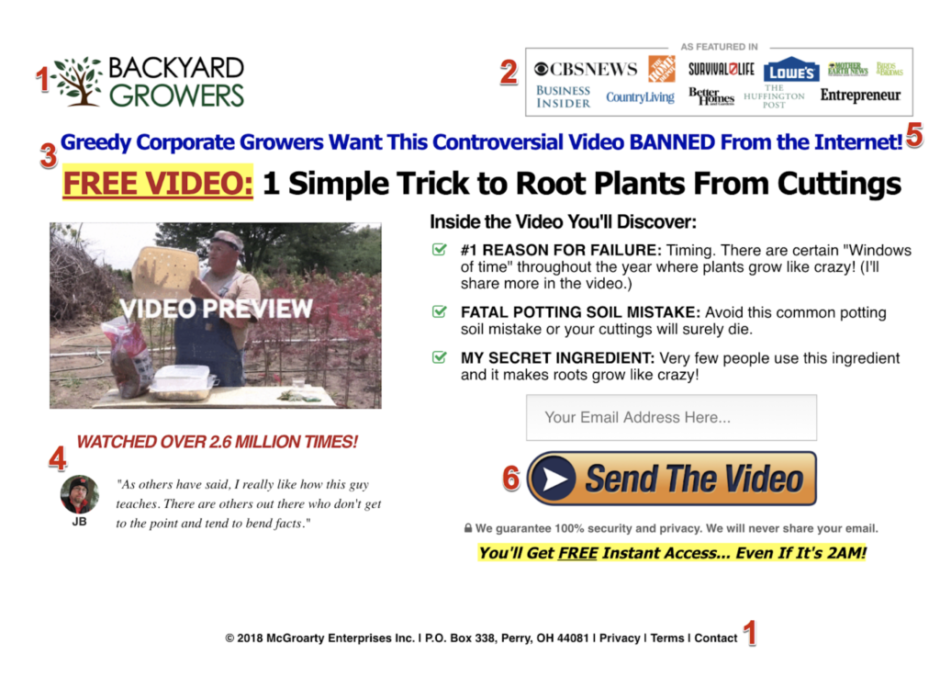
#1: Identity
These are things like a logo, business name, contact details (address, phone, email), and privacy policy.
Including these items on your page makes the visitor feel at ease.
#2: Credibility
These are things like “As seen on” (related authority websites), trust logos, etc.
Don’t think that you have to have been featured on popular sites in order to use this one.
Check out the example below of how I did this in the woodworking niche as an affiliate:
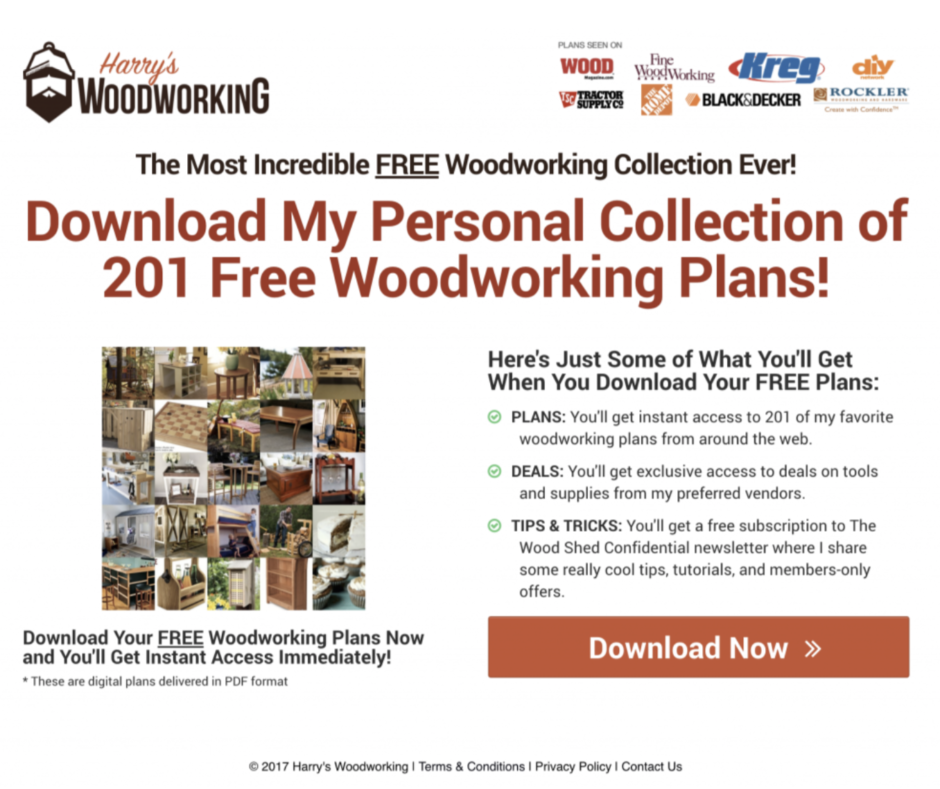
See how I added logos of companies that invoke trust in the mind of the prospect? All I did was add the line “Plans Seen On” above it.
Now, the plans did actually come from those sites so it was true.
#3: Relevance
This is one simple, make sure your content is related to what your prospect is interested in. Pretty obvious.
Try and make the entire experience for the visitor as congruent as possible… from the ad to the landing page to the thank you page to the affiliate offer.
#4: Social Proof
These are things like testimonials, download counters, and real-time notification pop-ups like Proof.
As an affiliate, it’s sometimes tough to get testimonials or download counters if you’re just getting started.
The best way to add social proof is with either the Proof real-time pop-up notifications or by including a snippet from a popular news site (or really any related site) that shows people are doing/using what you’re offering.
Here’s an example of a news snippet about the Keto Diet that you could use to add credibility and social proof if you were in that niche:
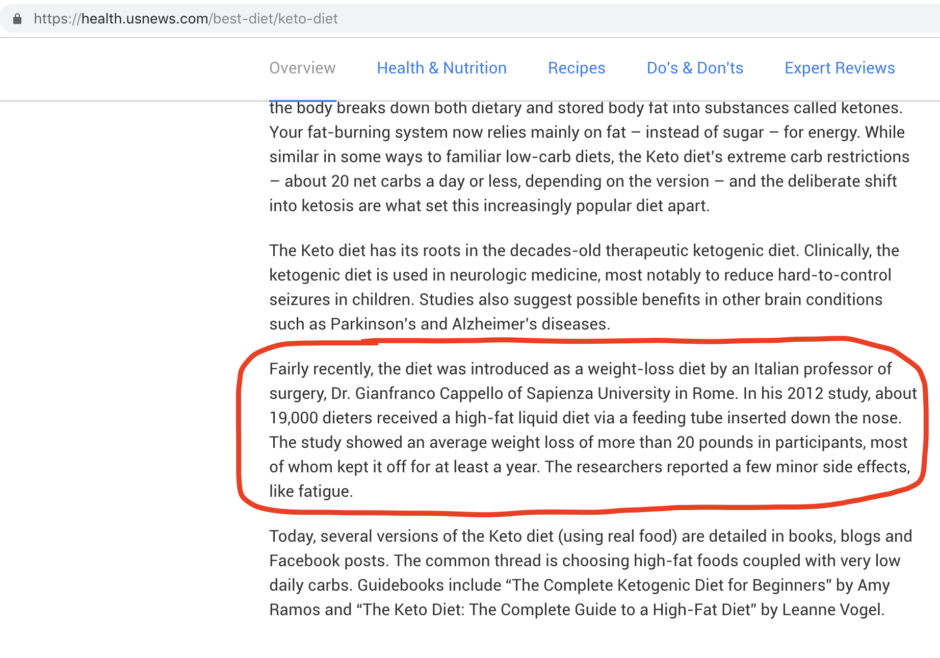
#5: Urgency
To add urgency, you could include things like “Warning” or “Limited Availability” or “Ending Soon”.
This is probably the hardest element of the 6 to add into your page. A lot of times it doesn’t make sense to add it.
One of the best ways to add urgency as an affiliate is to include a line of text near your call-to-action for your lead magnet that says something like… “Grab This Report While It’s Still Free.”
Another way I’ve done it is to create an enemy who doesn’t want your message to get out. Like the one I used on our gardening squeeze page above… “Greedy Corporate Growers Want This Controversial Video Banned From the Internet.”
This type of language adds a sense of urgency for the visitor to take action.
#6: Usability
These are things like button colors and layout of the page. You want your visitors to know exactly what to do once they land on your page.
Don’t give them a hundred places to click around. Make it easy for them to take the next step.
More than that, they should KNOW that’s the next step… the ONLY step.
Using a hybrid strategy like this ensures you’re not only getting the most interested people to subscribe but also the highest conversion rate.



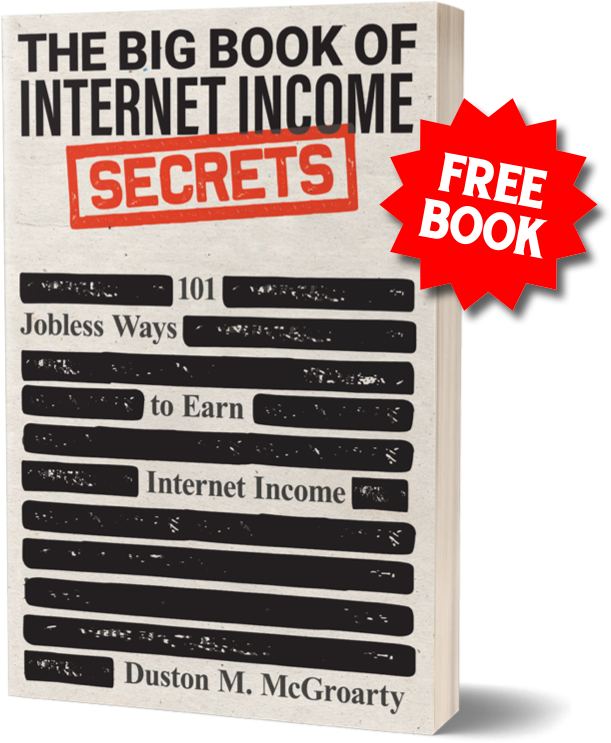

6 Responses
Hey man, great post I learned a lot! Question: When running paid ads to a “Blog -> Squeeze Page” funnel do you use single or double opt-in? And also the reasoning behind your choice.
Thanks, Mario! Personally, I rarely use double opt-in (DOI). SOI vs. DOI is obviously a personal preference. There are advantages and disadvantages to both. Here’s why I rarely use DOI… the biggest benefit of DOI is you’re making people jump through more hoops to get on your list, which means you’ll only have high-quality prospects on your list. This also means you won’t be sending emails to the people who enter fake addresses just to get your freebie. From my experience, there’s a significant percentage of DOI’s who are high-quality prospects but they never complete the second step (the confirmation step) of the DOI process.
Instead, here’s what I do… I set up my email list as SOI, I make them opt-in for a freebie, and I make them go to their email inbox to get the freebie. I rarely give them access to what they opted in for right on the thank page. This requires people to enter a real email address in order to get my freebie. I also have a pretty strict set of email engagement rules I use. If they haven’t opened an email in the last 3 months, they go onto a reactivation list. If they don’t “reactivate” after that 3-email sequence is over, they’re put on a suppression list.
Thanks for replying man. Yeah, I notice too a huge chunk don’t confirm their email which makes it bit hard with paid ads. But requiring them to go open their email to get the offer is a simple yet neat hack. Thanks again. Looking forward for more email-focused content.
Hi Duston, Amazing article, I just have one query, I am quoting this “Send your traffic to a blog-post-style landing page (or an actual blog post if you have one) and link out to a classic squeeze page.”
So you are saying to write a detailed blog post about keto diet and hyperlink it to the classic squeeze page which has those 6 elements right?
Is there any other way to connect blog post to the squeeze apart from the exit opt-in?
Thanks
Thanks, Nayeem! I use all kinds of different opt-ins on my blogs. Go to one of our gardening blogs, https://mikesbackyardnursery.com, and take a look at all of the different opt-in opportunities I give people. New visitors will see a generic “Join Thousands of Gardeners” pop-up after scrolling halfway down any blog post. You’ll see text links (with red call-out words first) scattered throughout each blog post. There’s a banner ad spot inside each blog post after the second paragraph. There’s an opt-in box right inside the sidebar on every page. There’s a banner ad at the bottom of the sidebar on every page. There’s an exit pop-up for new visitors. I manage a lot of that with the OptinMonster plugin.
Thanks for great content… will put your suggestions in action and will report back.